International Journal of Computer Network and Information Security @ijcnis
Статьи журнала - International Journal of Computer Network and Information Security
Все статьи: 1177
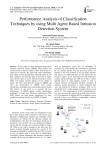
Статья научная
In this paper we have designed Agent based intrusion detection system (ABIDS) where agents will travel between connected client systems from server in a client-server network. The agent will collect information from client systems through data collecting agents. It will then categorize and associate data in the form of report, and send the same to server. Intrusion detection system (IDS) will support runtime addition of new ability to agents. We have illustrated the design of ABIDS and show the performance of ABIDS with various classification techniques that could produce good results. The motive of the work is to examine the best performance of ABIDS among various classification techniques for huge data. Moreover sophisticated NSL KDD dataset are used during experiments for more sensible assessment than the novel KDD 99 dataset.
Бесплатно
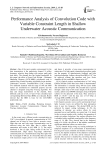
Статья научная
One of the most complex environment for the data transmission is the underwater channel. It suffers frequency selective deep fading with serious multi path time delay. The channel also has limited bandwidth. In this paper, the effect of Least Code Weight – Minimum Hamming Distance (LCW-MHD) polynomial code is studied using Viterbi Decoding Algorithm for the shallow Underwater Acoustic Communication (UAC) channel. Two different channels with the range of 100 and 1000 meters are considered for simulation purpose and the channel is designed using Ray Tracing algorithm. For data and image transmission in the channel, three different code rate of 1/2, 1/3 and 1/4 are considered and corresponding Bit Error Rate (BER) are evaluated. Result showed that the BER is least for the LCG-MHD polynomial code.
Бесплатно
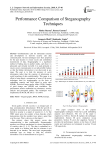
Performance comparison of steganography techniques
Статья научная
Confidentiality calls for substantial research and development in network security and data communication. Several techniques have been proposed for the past decades to ensure secure and confidential transmission of data. Steganography is a significant method of hiding data in another media, such that it is physically and virtually invisible. It is used primarily to ensure secure communication in an indiscernible fashion so that the hidden information is not discovered at any stage. The goal is to hide the presence of secret information rather than the contents of information to avoid breaching of data confidentiality. This paper is an effort to bring about a comparison of some of the recent techniques used for steganography on the basis of embedding capacity and Peak signal to noise ratio (PSNR), Universal image quality index (UIQI), Number of pixel change rate (NPCR) and correlation. The performance metrics undertaken are robustness, security analysis and perceptual quality. The techniques were implemented in MATLAB 2013a v 8.1.0.604.
Бесплатно
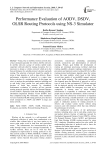
Performance evaluation of AODV, DSDV, OLSR routing protocols using NS-3 simulator
Статья научная
Today, Due to mobility wireless network have a heavy demand especially for wireless Ad-Hoc network. In Ad-Hoc network a group of wireless mobile nodes cooperate with each other by routing of packets. So it is necessary to design a wireless network which gives the best performance by suitable protocol selection and path routing. The selection of protocol should be suitable in terms of data integrity as well as data delivery. Hence performance evaluation of protocol is a major issue before selection of a routing protocol. In this paper our aim is to analyse the performance matrices including end to end delay, jitter, packet loss and packet delivery fraction of multi hop network by simulation. Performance evaluation of wireless ad hoc network routing protocols specially Ad-hoc On Demand Distance Vector (AODV), Optimized Link State Routing (OLSR), Destination Sequenced Distance Vector (DSDV) have been completed using NS-3 Simulator. After simulation we have found that OLSR routing protocol gives the best result comparison to AODV and DSDV in large and dense network.
Бесплатно
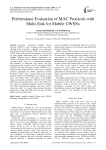
Performance evaluation of MAC protocols with multi-sink for mobile UWSNs
Статья научная
Currently, Underwater Wireless Sensor Network (UWSN) is one of modern science and have attached many researchers especially how interesting with Wireless Sensor Network (WSN). A mobile node in UWSN is one of the powerful mechanisms, it can be used for many aquatic applications such as Surveillance for wildlife, Pollution control, Military applications, etc. UWSN is different from the terrestrial network in terms of using acoustic waves as a communication medium. Due limitation of bandwidth, high latency, and long propagation delay of acoustic waves, many proper MAC protocols that work efficiently in Static UWSN are not suitable for the mobile network. In this article two MAC protocols appropriate for mobile underwater network Broadcast as Direct access and geo-routing aware MAC protocol (GOAL) as Handshaking are evaluated, in both static and mobile nodes with respect to throughput, energy consumption, and delay. Then the effect of using Multi-Sink on the performance is shown, the evaluation is done based on AquaSim simulator, Aqua3D Animator, and AWK programming language have been used to extract the results. As a result, the performance has been improved by using multi-Sink with two types of MAC address, and for all the metrics.
Бесплатно
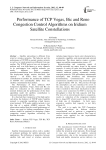
Статья научная
Satellite networking is different from wired or wireless networks. The behavior and the performance of TCP/IP in normal wireless network as well as in wired network are different from one another. The TCP/IP protocol was not designed to perform well over high-latency or noisy channels so its performance over satellite networks are totally different. Each satellite networks/constellations have different properties. The deployment height, motion, direction, link capacity – all differ from one satellite constellations to another. So, certainly the behavior of TCP/IP will considerably differ from one satellite constellations than another. The Performance of three different TCP Congestion algorithms, Vegas, Reno and Bic are taken for evaluation on the simulated satellite network Iridium and the performance of the three algorithms under the satellites constellation is measured using suitable metrics. It is observed that, irrespective of the high end to end delay, the behavior of TCP/IP under Satellite network is somewhat resembling a high latency wired network. TCP under satellite network is not like that of a mobile ADHOC network. The observation resulted that the overall performance of Vegas was good in Iridium constellations. These reasons should be explored for designing a better congestion control algorithm exclusively for Satellite Networks.
Бесплатно
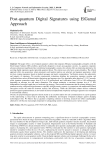
Post-quantum Digital Signatures using ElGamal Approach
Статья научная
The paper offers a novel digital signature scheme that integrates ElGamal cryptographic principles with the Short Integer Solution (SIS) problem, specifically designed to ensure post-quantum security. As quantum computers advance and present significant risks to traditional cryptographic systems, this scheme offers an interesting alternative for securing digital signatures against potential quantum threats. The scheme uses only basic secure principles. The offered approach offers key generation, where parameters and random matrices are selected, and signature generation, which involves creating signatures based on hashed messages and matrix computations. Verification ensures the authenticity and integrity of signatures. We provide experimental evaluations detailing key generation, signature creation, and verification times across different matrix dimensions and message sizes. Key generation takes between 2.5–10.2 seconds, while signature generation ranges from 0.20 to 9.30 milliseconds and verification from 0.18 to 8.90 milliseconds, depending on message size and matrix dimension. The scheme maintains a consistent signature size of 1.7 KB, independent of message length due to a hash-and-sign strategy. These results demonstrate that the scheme balances post-quantum security with practical performance, especially in high-security contexts. A comparison with traditional ElGamal encryption reveals the trade-offs between security and efficiency. While the SIS-based scheme delivers enhanced protection against quantum threats, it also entails increased computational complexity and larger signature sizes compared to conventional schemes.
Бесплатно
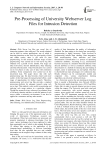
Pre-Processing of University Webserver Log Files for Intrusion Detection
Статья научная
Web Server log files can reveal lots of interesting patterns when analyzed. The results obtained can be used in various applications, one of which is detecting intrusions on the web. For good quality of data and usable results, there is the need for data preprocessing. In this research, different stages of data preprocessing were carried out on web server log files obtained over a period of five months. The stages are Data Conversion, Session Identification, Data Cleaning and Data Discretization. Data Discretization was carried out in two phases to take care of data with continuous attributes. Some comparisons were carried out on the discretized data. The paper shows that with each preprocessing step, the data becomes clearer and more usable. At the final stage, the data presented offers a wide range of opportunities for further research. Therefore, preprocessing web server log files provides a standard processing platform for adequate research using web server logs. This method is also useful in monitoring and studying web usage pattern in a particular domain. Though the research covers webserver log obtained from a University domain, and thus, reveals the pattern of web access within a university environment, it can also be applied in e-commerce and any other terrain.
Бесплатно
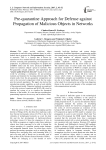
Pre-quarantine Approach for Defense against Propagation of Malicious Objects in Networks
Статья научная
This paper revisits malicious object propagation in networks using epidemic theory in such a manner that it proposes the (Pre-quarantining) of nodes in networks. This is a concept that is known by experience to be a standard disease control procedure that involves screening and quarantining of immigrants to a population. As preliminary investigation we propose the Q-SEIRS model and the more advanced Q-SEIRS-V model for malicious objects' spread in networks. This Pre-quarantine concept addresses and implements the "assume guilty till proven innocent" slogan of the cyber world by providing a mechanism for pre-screening, isolation and treatment for incoming infected nodes. The treated nodes from the pre-quarantine compartment are sent to the recovered compartment while the free nodes join the network population. The paper also derived the reproduction number, equilibria, as well as local stability of the proposed model. Numerical methods are employed to solve the system of equations and MATLAB is used to simulate the system so as to visualize the dynamical behavior of the models. It is seen that pre-screening/pre-quarantining improves the recovery rate in relative terms.
Бесплатно
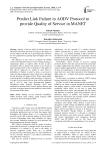
Predict Link Failure in AODV Protocol to provide Quality of Service in MANET
Статья научная
Quality of Service (QoS) in Ad hoc networks (MANETs) and more precisely in routing is the subject of several studies with the aim of providing better solutions for new applications requiring high throughput and very low delay. The objective of this work is to enhance the AODV (Ad hoc On Demand Distance Vector) routing strategy in maintenance phase, to improve QoS. It aims to add a mechanism able to predict link failure in use based on signal strength which is able to determine if the quality of link will be improved (i.e. stable) or more bad (i.e. probability of failure) in order to allow us not only to make the link management more robust but to anticipate on link breaking and improve QoS. When signal quality is declining due to neighbor node remoteness, a discovery of a part of road rescue with two hops will be established and it will be used when disconnection happens. Simulations under Network Simulator (Ns2) were conducted to measure traffic control, packets delivery and lost ratio in original protocol and modified version which are presented in this paper.
Бесплатно
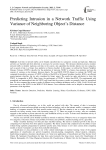
Predicting Intrusion in a Network Traffic Using Variance of Neighboring Object’s Distance
Статья научная
Activities in network traffic can be broadly classified into two categories: normal and malicious. Malicious activities are harmful and their detection is necessary for security reasons. The intrusion detection process monitors network traffic to identify malicious activities in the system. Any algorithm that divides objects into two categories, such as good or bad, is a binary class predictor or binary classifier. In this paper, we utilized the Nearest Neighbor Distance Variance (NNDV) classifier for the prediction of intrusion. NNDV is a binary class predictor and uses the concept of variance on the distance between objects. We used KDD CUP 99 dataset to evaluate the NNDV and compared the predictive accuracy of NNDV with that of the KNN or K Nearest Neighbor classifier. KNN is an efficient general purpose classifier, but we only considered its binary aspect. The results are quite satisfactory to show that NNDV is comparable to KNN. Many times, the performance of NNDV is better than KNN. We experimented with normalized and unnormalized data for NNDV and found that the accuracy results are generally better for normalized data. We also compared the accuracy results of different cross validation techniques such as 2 fold, 5 fold, 10 fold, and leave one out on the NNDV for the KDD CUP 99 dataset. Cross validation results can be helpful in determining the parameters of the algorithm.
Бесплатно
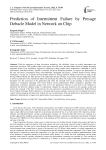
Prediction of Intermittent Failure by Presage Debacle Model in Network on Chip
Статья научная
With the emergence of deep sub-micron technology, the reliability issues in on-chip interconnect has enormously increased. This includes single event upsets, like soft errors, and hard faults which are rapidly becoming important factors to be considered. Aggressive technology scaling renders these architectures vulnerable to system performance, intermittent failure, capacitive crosstalk, and power dissipation problem. To improve the performance of the area and power consumption along with bandwidth, throughput and latency, a Buffer Potency Power Gating Technique is carried out to predict the Intermittent Failure by Presage Debacle Model in Network on Chip. In the Presage Debacle Model, the links present in the application-specific topology are provided with real application traffic to assist in prediction of the intermittent failure. By predicting the failure, the output of the model provides the power dissipated over the connection of the application link. Then the crosstalk noise in the topology is reduced by the Adaption of Simulated Annealing (SA) based Particle Swarm Optimization (PSO) congruence algorithm. The optimization congruence algorithm assigns each task in the application software to each node in the topology to determine the network's optimal output. It continuously changes the task park position in the topology system and reduces the crosstalk of the NoC. Consecutively, the area and power consumption are minimized by Buffer Potency Power Gating Technique. Buffer efficiency is increased and the power-gating is a practical way to mitigate NoC power control schemes properly and effectively without any loss in performance. Thus the prediction of intermittent failure is obtained by utilizing NoC to improve the performance of area and power consumption.
Бесплатно
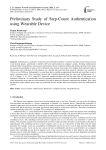
Preliminary Study of Step-Count Authentication using Wearable Device
Статья научная
Authentication, an identity verification and confirmation method, is a defense mechanism that reduces the risk of adversarial attacks, specifically to identity theft and impersonation in computer systems. Existing authentication methods exhibit vulnerabilities, such as password dictionary attack, credential stuffing, and identity spoofing. In this study, we examine the possibility of using a class of biometric data, namely step counts, to investigate their potential in person identification and verification. For this purpose, we collected step-count data from research volunteers over a period of 33 days or over 560 hours. Subsequently, we used these data to establish an appropriate threshold and tested their accuracy using a confusion matrix. Our evaluations showed that a suitable threshold range for step-count authentication is x ̅-1S.D.≤Range ≤ x ̅+1S.D., where S.D. represents standard deviation and x ̅ is the mean value of step counts of an individual. Moreover, we constructed a receiver operating characteristic curve and calculated the area under the curve, which showed that step counts have the potential to be used in behavioral biometric authentication methods. Thus, using the threshold range method, step counts can potentially become another behavioral biometric factor for authentication systems.
Бесплатно

Preventive Aspect of Black Hole Attack in Mobile AD HOC Network
Статья научная
Mobile ad hoc network is infrastructure less type of network. In this paper we present the prevention mechanism for black hole in mobile ad hoc network. The routing algorithms are analyzed and discrete properties of routing protocols are defined. The discrete properties support in distributed routing efficiently. The protocol is distributed and not dependent upon the centralized controlling node. Important features of Ad hoc on demand vector routing (AODV) are inherited and new mechanism is combined with it to get the multipath routing protocol for Mobile ad hoc network (MANET) to prevent the black hole attack. When the routing path is discovered and entered into the routing table, the next step is taken by combined protocol to search the new path with certain time interval. The old entered path is refreshed into the routing table. The simulation is taken on 50 moving nodes in the area of 1000 x 1000 square meter and the maximum speed of nodes are 5m/sec. The result is calculated for throughput verses number of black hole nodes with pause time of 0 sec. to 40 sec., 120 sec. and 160 sec. when the threshold value is 1.0.
Бесплатно
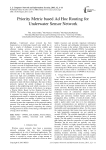
Priority Metric based Ad Hoc Routing for Underwater Sensor Network
Статья научная
Underwater sensor network has been burgeoned as an interesting research area which has to face a couple of challenges to provide scalable and efficient routing services because of its unique characteristics. In many aspects, it differs from the ground based terrestrial sensor network, Firstly, In UWSNs, acoustic signal is used instead of radio-frequency that attenuates much in underwater environment in comparison with radio-frequency channels. Acoustic channels attribute much lower bandwidth and the propagation speed of acoustic signals in water is several of magnitudes longer. Secondly, nodes of underwater sensor networks move with water current which results dynamic topology. Thirdly, underwater sensor networks consume more power than terrestrial networks due to the underwater channel characteristics and it has high error probability because of acoustic underwater channels' sensibility in noise, multi-path and Doppler spread. Some routing protocols have been proposed to deal with these challenges. But most of these protocols espouse the greedy technique to forward packets to the neighboring node which consumes a lot of energy when network is dense. In this thesis, we propose a Priority Metric Based Ad hoc Routing Protocol for UWSNs. The leading advantages of the protocol are that it consumes less energy in dense network as only one neighboring node needs to capture the packet and process it and it guarantees less number of packet loss in high mobile node environment. Extensive simulation is executed to attest the competence of the proposed routing protocol. The result and analysis bear the indication of the proposed routing protocol's surpassing the existing routing protocol in terms of total energy consumption and average end to end delay.
Бесплатно
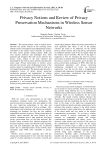
Privacy Notions and Review of Privacy Preservation Mechanisms in Wireless Sensor Networks
Статья научная
The current research work in wireless sensor networks has mostly focused on the resolving issues related to power consumption and computational resource constraints in the wireless sensor networks .To achieve the same various specific routing schemes ,MAC and cross layered protocols and techniques have been proposed and designed .But with recent advances the privacy issues related to the data collected and transmitted by the wireless sensor networks had taken the center stage .Privacy preservation in wireless sensor networks has become more challenging because of the wireless nature of communication in WSN as well as its self organizing architecture. The present paper provides a comparative review of various privacy preserving mechanisms proposed and implemented in wireless sensor networks with respect to the privacy notions of k-anonymity and L-diversity. Along with the discussion and analysis the present work is an effort for the pavement of a way towards the future research in the field of privacy preservation in WSN.
Бесплатно
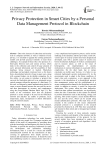
Privacy Protection in Smart Cities by a Personal Data Management Protocol in Blockchain
Статья научная
Due to the increase of cybercrime and security risks in computer networks as well as violations of user privacy, it is essential to upgrade the existing protection models and provide practical solutions to meet these challenges. An example of these risks is the presence of a third party between users and various services, which leads to the collection and control of large amounts of users' personal information and the possibility of their databases being misused or hacked. Blockchain technology and encrypted currencies have so far shown that a decentralized network of peer-to-peer users, along with a general ledger, can do reliable computing. So, in this article, we are going to introduce a protocol that converts the blockchain network to an automated access control manager without the presence of a third party. To this end, we designed a mutual authentication protocol to create a secure channel between the user and the service and then demonstrate its accuracy and completeness using the Gong-Nidham-Yahalom belief logic [1]. The results of our evaluations show that our proposed protocol is secure enough to be used on the blockchain network and attackers are unable to penetrate, track, impersonate, inject, misrepresent or distort information using the common attacks.
Бесплатно
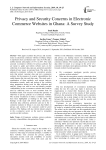
Privacy and security concerns in electronic commerce websites in Ghana: a survey study
Статья научная
This paper examines the privacy and security issues on electronic commerce websites in Ghana. Ghana is reported to have an Internet users’ rate of 27.8% and a mobile Internet subscription of 14% in 2017. The study assessed e-commerce websites for privacy policies that are meant to guide and inform website users on the collection of customer data, data use, protection and other related privacy issues on personal data. The study also analyzed e-commerce websites for encryption security tools that protect customer data and test e-commerce websites for the presence of security vulnerabilities that could threaten the sites and their users. The study used a combination of three methods; web content analysis, information security audit and testing of the websites using penetration testing tools for data collection and analysis. Nmap was used to test and identify possible vulnerabilities on the e-commerce websites that could be used by malicious users to steal customer data for fraudulent intent. The research revealed the presence or otherwise of privacy policies on e-commerce websites. The security weaknesses in these e-commerce websites have been highlighted as findings in the study. The findings of the study will inform policy direction on electronic data collection, protection and use in the e-commerce industry in Ghana is on areas that bother on privacy and security of the customer could be given attention. The findings will also inform industry players in the e-commerce sector on the need to strengthen security on their websites.
Бесплатно

Proof of Notoriety: A Promised Consensus Mechanism for the Blockchain-based Copyright System
Статья научная
In blockchain technology, copyright protection can be achieved through the use of smart contracts and decentralized platforms. These platforms can create a tamper-proof, timestamped record of the creation and ownership of a work, as well as any subsequent transactions involving that work. The choice of platform or type of blockchain is mainly dependent upon the type of consensus algorithm. This article presents a novel approach to copyright protection using blockchain technology. The proposed approach introduces a new consensus mechanism called Proof of Notoriety (PoN) to enhance the security and efficiency of copyright registration and verification processes. The Proof of Notoriety consensus mechanism leverages notoriety scores to determine the validity and credibility of the participants in the copyright registration process. Participants with higher notoriety scores are given more weightage in reaching a consensus on the validity of copyright claims. This ensures that only reputable entities are responsible for registering and verifying copyright, thereby reducing the risk of fraudulent claims and unauthorized use.
Бесплатно
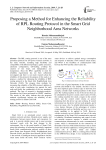
Статья научная
The RPL routing protocol is one of the most prominent protocols for low-power wireless networks. It has many benefits, including high flexibility and compatibility with different topologies, quality assurance, automatic configuration, self-healing, avoiding the creation of tree loops, and independence and transparency. Since the RPL's capability to meet the reliability requirements has not been sufficiently investigated and there is not much research about the reliability of this protocol, the purpose of this study is to propose a method for enhancing the reliability of RPL routing protocol in the Smart Grid Neighborhood Area Networks (NAN). We propose three methods for increasing the reliability of the RPL protocol: addition of cache at each node, considering two parents for each node and finally the combination of the two mentioned methods. The type of research is descriptive-analytic. Simulations have been performed in OPNET simulator. The results of this study indicate that the proposed methods significantly increase the reliability of this routing protocol in Smart Grid NAN.
Бесплатно

